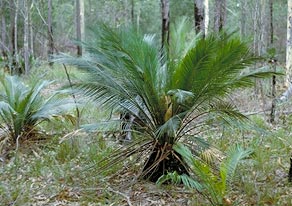|
Common name:
Burrawang, cycad
Family name:
Zamiaceae
Botanical name:
Macrozamia communis
Flowering/fruiting season:
Forms cones after fire, mainly winter (Gott, 1995)
Location:
Open forests
|  |
Use:
- Food, technology
- 'Seed known to have been used as a food source, though it is toxic and must be leached of poison before use.
- Strong barbed leaf shafts were once used to make tools.'
- 'The old fellas used to eat them but they would put them in the creek and let the water wash them.' (Wreck Bay Community & Renwick, 2000:19)
Notes:
- Male and female seed cones are on separate plants and the large female seeds are ripe when red or yellow.
- ' … highly poisonous red seeds contain starch. Aboriginal people use various methods to treat seeds before eating them. Pounded seeds are washed in running water for some days. The pulp is then made into cakes and roasted. However, there is no evidence that this treatment destroys or even reduces the poisons.' (Stewart & Percival, 1997:37)
See Beaton, 1982:51-9 for evidence that processing reduces the toxins.
Language names:
bung-gou, ib-bur : 'nut' Dhurga, S. coast NSW (Gott, 1995)
Horticulture :
Attractive rockery feature plant - dark green palm-like leaves up to 2m long. Good drainage essential; some shade desirable (Wrigley & Fagg, 1998:172)
Similar species:
M. fawcettii, M. spiralis
Use code:
SEED
« « Go Back | Return to Top of Page


